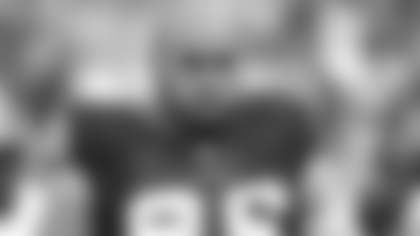With his Achilles tendon torn and surgery ahead, Ma'ake Kemoeatu thought that perhaps his days in the NFL had come to an end.
Sixteen months after the injury and with a change of scene and lots of effort, he's not only the Redskins' starting nose tackle but an honored member of a select group.
The Redskins announced Thursday that Kemoeatu had been named the winner of the Ed Block Courage Award. Named for the long-time head athletic trainer of the Baltimore Colts, this award is given annually by each team to a player who displays extraordinary courage in the face of adversity. The winner is chosen by his teammates.
That's the part that seemed to mean the most to the 6-5, 350-pound Kemoeatu.
"I think the most gratifying thing about it is that you have the support of your teammates. It's my first year here and my teammates had to get to know me first. I got here in April, trying to recover from the torn Achilles and making a comeback and my teammates respected that," he said.
Kemoeatu, 31, broke into the NFL in 2002 with the Baltimore Ravens as undrafted rookie from the University of Utah. He started all 16 games in 2005 and, as a free agent, signed with the Carolina Panthers in 2006. He played three seasons and then, on the opening day of training camp in 2009, tore his Achilles tendon during drills, landing him on the injured reserve list.
First he tried to deal with the shock of what had happened. Then the reality hit.
"The day that I tore it, the trainers said, 'You're done.' I was like, 'I'm done? I'm done for the day? Tape me up and put me back out there.' They said, 'No, you're done for the season. You tore your Achilles and it takes a whole year to come back from.' So it did cross my mind that football could be over for me. It had been eight years, and football is not forever. It can be over any time," Kemoeatu said.
Last spring, he thought he would remain with the Panthers.
"The week before they cut me they brought me in on Monday and I started working out and my hopes started going up and I thought we were really going to make a run for this. We worked out Monday, Tuesday, Wednesday, Thursday and I was thinking I'm putting in good work and they told me they were going to release me and I went home thinking football may be over," he said.
"Three or four days later, the Redskins called. Seattle called. New Orleans called. So I changed teams. I came here and the guys took care of me."
"The guys" include head athletic trainer Larry Hess, associate athletic trainer Eric Steward, physical therapist Elliott Jermyn and head strength and conditioning coach Ray Wright and his staff.
This was no ordinary rehabilitation. The massive Kemoeatu ballooned to 392 pounds due to inactivity and diet and was now moving back to nose tackle in the Redskins' new 3-4 alignment after playing in Carolina's 4-3. He needed a second surgery when he developed an infection that required a skin graft. He was also in the hands of relative strangers. His dedication and theirs made his return a success.

"With his injury, and being off for so long and not being able to put any weight on the leg, he got de-conditioned," Hess said. "Because of the infection, it was still a sensitive area and we still had to watch the healing once we had signed him. Once we were able to push a little more, he was behind because of his cardio and his overall endurance and strength, so he had to put in double the work everyone else did during the off-season. He really worked hard. He really didn't have any down time as he prepared for the season and to come back."
When Kemoeatu went home to Hawaii with his brother, Pittsburgh Steelers guard Chris Kemoeatu, Wright accompanied him to continue the conditioning. The brothers sponsor an international rugby tournament but the Redskins did not want Kemoeatu falling off his exercise and diet regimen even for a short while
Wright moved in with his protégé's family for five days. He and Kemoeatu held a workout in the morning at the University of Hawaii, watched rugby in the afternoon and then worked out again while enjoying the beauty of the Pacific. Kemoeatu's house is about 100 yards from the ocean.
"Mountains and rainbows make your workouts not so bad," Wright said.
Kemoeatu's new teammates watched him labor, saw his progress and grew to respect the time and effort he devoted to his comeback.
"You never hear Kemo complain about one thing. He just goes about his work very hard, very quietly. I don't think there could be a better recipient of that award than him after what he has illustrated through this past year," said center Casey Rabach, who battles Kemoeatu daily in practice. "He's obviously a big part of what we do here on defense and a great guy to have around."
Regaining health and durability are only part of the picture. There's also the fear factor, regaining the faith that the rebuilt body part can hold up against football's rigors.
"That's the main thing, trusting it again. You know you're healed, you feel like you're healed but you don't want to put weight on it, you're thinking about it, and you just have to trust that it's going to be OK and you can go out there and do anything," said defensive end Phillip Daniels.
He knows. In 2008, Daniels tore knee ligaments on the opening day of Redskins' training camp and missed the season. He returned in 2009 and was the team's Ed Block Courage Award winner last year.
"To see a guy work as hard as he did to get back, I sympathized with him because I've been through it," he said.
Kemoeatu has played in all 11 games this season, starting 10, and has 28 total tackles (22 solo). The best, however, is yet to be.
"The first year back is always the roughest," Daniels said. "An injury like that can take a year of playing just to get back because you were out of football so long. Next year will be his year."
Larry Weisman, an award-winning journalist during 25 years with USA TODAY, writes for Redskins.com and appears nightly on Redskins Nation on Comcast SportsNet. Read his Redskinsblitz blog at Redskinsrule.com and follow him on Twitter.com/LarryWeisman.






